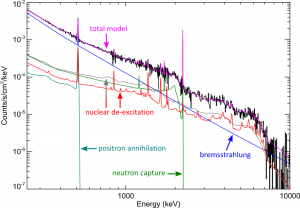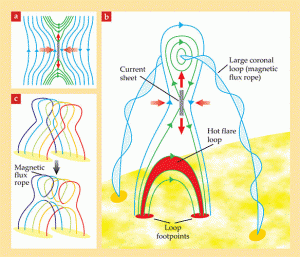GRIPS will shed light on a number of solar-flare mysteries, including:
- What causes the spatial separation between energetic electrons producing hard -rays and energetic ions producing gamma-ray lines?
- What are the angular distributions of accelerated electrons and ions?
- Why do relativistic electrons dominate in the corona?
The Sun as a laboratory
The Sun is the most energetic particle accelerator in the solar system, producing ions up to tens of GeV and electrons up to hundreds of MeV, in both large solar flares and fast coronal mass ejections (CMEs), but through different physical mechanisms. Solar flares are the most powerful explosions in the solar system, releasing up to 10^32–10^33 ergs in 100–1,000 seconds, with up to tens of percent of this energy in flare-accelerated electrons and a comparable amount in flare-accelerated >~1 MeV ions. However, the processes behind this impulsive release of stored magnetic energy are still not well understood.

The hard X-ray/gamma-ray spectrum from the 2002 July 23 X-class solar flare highlighting the different components of emission at these energies
High-energy emissions are the most direct signature of the acceleration of electrons, protons, and heavier ions in solar flares. Energetic electrons produce a hard X-ray and gamma-ray continuum through a process called bremsstrahlung. Energetic ions collide with the ambient solar atmosphere to produce a complex spectrum of narrow and broad gamma-ray lines that contain unique information on not only the accelerated ions but also the ambient solar atmosphere. Thus, it is by observing these emissions that we learn what is going on at the Sun during these powerful events.
The biggest mystery

RHESSI observed compact ion-associated footpoints (blue) that are not in the same position as the electron-associated footpoints (red), contrary to expectation
Most of the progress this century in understanding the high-energy aspects of solar flares has resulted from the wealth of observations by the RHESSI mission. According to the RHESSI team, the most important result of RHESSI‘s 13+ years of observations is the discovery of gamma-ray footpoint structures. For all of the largest flares observed by RHESSI, >~10 MeV ions are localized to the vicinity of the flare, and in the largest flare, RHESSI can distinguish two ion-associated footpoints that closely parallel the electron-associated footpoints (see figure). Thus, RHESSI established that flares accelerate ions in a similar manner to how they accelerate electrons.
However, this same observation shows a surprising and as-yet-unexplained spatial separation between the footpoints of the two types of particles. Electrons and ions that are accelerated by the same flare processes are expected to produce footpoints in the same locations. To address this mystery, GRIPS is using new technologies that can produce gamma-ray images with higher angular resolution and higher sensitivity.
The rest of the story
(more to follow)

